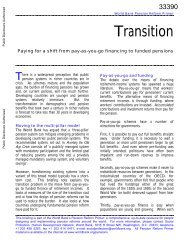Financial Sector Development in Africa: Opportunities ... - World Bank
Financial Sector Development in Africa: Opportunities ... - World Bank
Financial Sector Development in Africa: Opportunities ... - World Bank
Create successful ePaper yourself
Turn your PDF publications into a flip-book with our unique Google optimized e-Paper software.
The Reform Agenda for <strong>F<strong>in</strong>ancial</strong> Regulation and Supervision <strong>in</strong> <strong>Africa</strong> 163<br />
Figure 5.4<br />
Relation between Capital Requirements and Supervisory Capacity<br />
Basel I Basel II Basel III<br />
High<br />
<strong>Africa</strong> today:<br />
Higher capitalization<br />
Required<br />
supervisory<br />
capacity<br />
Low<br />
<strong>Africa</strong> today:<br />
Lower supervisory<br />
capacity<br />
Standardized<br />
approach<br />
Internal<br />
rat<strong>in</strong>gs–based<br />
approach<br />
Quality<br />
Leverage ratio<br />
Capital buffers<br />
Too-big-to-fail<br />
Required<br />
regulatory<br />
capital a<br />
Source: Authors.<br />
a<br />
Required regulatory capital for the same amount of corporate credit risk under Basel I, Basel II, and Basel III. The<br />
gray dots connected by the dotted l<strong>in</strong>e <strong>in</strong>dicate the level under all three frameworks.<br />
which is even more daunt<strong>in</strong>g when start<strong>in</strong>g from a low base. At the same<br />
time, Basel II allows banks, especially those adopt<strong>in</strong>g the advanced IRB<br />
approaches, to considerably reduce regulatory capital. There is a fundamental<br />
difference, though, between a move from Basel I to Basel II and<br />
the adoption of the 2010 Basel III reforms: Basel III does not <strong>in</strong>clude a<br />
trade-off between the two stability anchors—capital and capacity—but it<br />
does conta<strong>in</strong> elements that <strong>in</strong>crease demands on capital and supervisory<br />
capacity at the same time. The potential value of these latest proposals for<br />
the reform agenda will be discussed below.<br />
In essence, the <strong>in</strong>troduction of Basel II <strong>in</strong>to <strong>Africa</strong>n jurisdictions<br />
requires a significant buildup of supervisory capacity to allow banks to<br />
leverage capital more efficiently. Conversely, Basel II does not provide an<br />
adequate framework to enhance f<strong>in</strong>ancial stability <strong>in</strong> <strong>Africa</strong>n countries if<br />
supervisory capacity rema<strong>in</strong>s low. <strong>Africa</strong>n supervisors often view high<br />
capital requirements as a way of compensat<strong>in</strong>g weak supervisory practices<br />
to safeguard f<strong>in</strong>ancial stability. But capital cannot replace adequate<br />
supervision—rather, it creates a false sense of security and can impose a<br />
significant burden on banks’ ability to <strong>in</strong>termediate the depositor funds<br />
at their disposal. The goals of ensur<strong>in</strong>g the ma<strong>in</strong>tenance of f<strong>in</strong>ancial stability<br />
and enhanc<strong>in</strong>g <strong>in</strong>termediation efficiency can be achieved jo<strong>in</strong>tly







